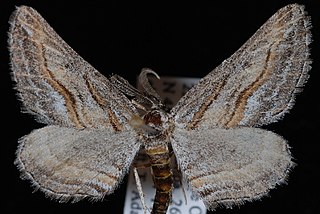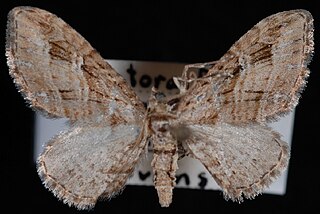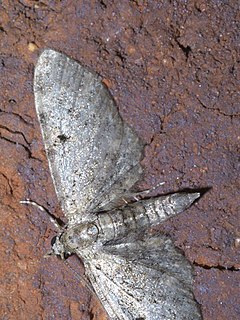Annaphila is a genus of moths of the Noctuidae family.
Dichagyris is a genus of moths of the family Noctuidae. The former genera Loxagrotis, Pseudorichia, Pseudorthosia and Mesembragrotis are now considered subgenera of Dichagyris. From Greek dikha-gyris 'apart, asunder; double' + 'the finest meal or flour'; English pronunciation: /digh-kuh-JIGH-riss/, IPA [dɑj•kə'dʒɑj•ɹɪs].

Anacamptodes is a genus of moths in the family Geometridae first described by McDunnough in 1920. There are around 40 species within the genus, although a number have been reassigned to the genus Iridopsis.
Antiphoides is a genus of moths in the family Geometridae. The genus was erected by Frederick H. Rindge in 1990.

Euchlaena is a genus of moths in the family Geometridae erected by Jacob Hübner in 1823.
Exelis is a genus of moths in the family Geometridae erected by Achille Guenée in 1857.
Glaucina is a genus of moths in the family Geometridae erected by George Duryea Hulst in 1896.

Hulstina is a genus of moths in the family Geometridae erected by Harrison Gray Dyar Jr. in 1903.
Pherotesia is a genus of moths in the family Geometridae. The genus was described by Schaus in 1901.

Sabulodes is a genus of moth in the family Geometridae.
Stenoporpia is a genus of moths in the family Geometridae erected by James Halliday McDunnough in 1920.

The Chrysauginae are a subfamily of snout moths. They are primarily Neotropical and include about 400 described species.
Eupithecia casloata is a moth in the family Geometridae. It is found in North America, including Yukon, British Columbia, Alberta, Saskatchewan, New Brunswick, Newfoundland and Labrador, Quebec, Washington, Montana, Oregon, Wyoming, Colorado, Utah, California, Maine and New Hampshire.

Eupithecia niphadophilata is a moth in the family Geometridae. It is found from British Columbia and western Alberta south to New Mexico.
Apatelodes is a genus of moths of the family Apatelodidae first described by Packard in 1864.
Caberini is a tribe of geometrid moths in the family Geometridae. There are at least 50 described species in Caberini.

Tornos is a genus of geometrid moths in the family Geometridae erected by Morrison in 1875. There are about 17 described species in Tornos.

The Hueneme, Malibu & Port Los Angeles Railway was a standard-gauge, 15-mile railroad in Malibu, California. It was founded by Frederick Hastings Rindge (1857–1905) and operated on his 13,000-acre ranch along the coast, which encompassed most of what is today Malibu. He struggled for years to keep trespassers off of his land, and feared that the Southern Pacific Company would use the power of eminent domain to build a railroad through his property. This threat animated Rindge to plan his own railroad to thwart the efforts of the Southern Pacific. This was part of his overall effort to keep outsiders off of his ranch and spoil what he considered to be paradise.









